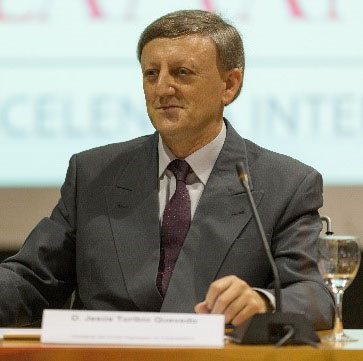Keynote Speaker

Prof. Dr. Jesús Toribio
Fracture and Structural Integrity Research Group (FSIRG), University of Salamanca (USAL), SpainSpeech Title: Innovative Approach to Fatigue Crack Propagation on the Basis of Microstructurally-Induced Locally-Deflected Crack Paths: A Tribute to Antonio Machado and Fray Luis de León
Abstract: The lecture deals with the microstructure-based anisotropic fatigue behaviour of hot rolled and cold drawn pearlitic steel wires, showing that: (i) the corresponding fatigue crack paths in both the hot rolled bar and the heavily cold drawn wire develop in global mode I in both materials, i.e., no macroscopic (apparent) anisotropic effect arise in the matter of fatigue crack propagation, in spite on the inherent microstructural anisotropy produced by heavy drawing in the commercial prestressing steel in the form of orientation in the wire axis or cold drawing direction of both microstructural levels of pearlitic colonies and lamellae; (ii) at a finer microstructural level, the associated fatigue micro-crack paths in both the hot rolled bar and the cold drawn wire exhibit frequent deflections (microstructurally-induced locally-deflected crack paths), thus generating a zig-zag micro-crack path with the result of local mixed mode in both materials, i.e. anisotropic fatigue behaviour and locally multiaxial fatigue crack growth), i.e., a microscopic (physical) anisotropic effect arises in the matter of fatigue crack propagation linked with the manufacture-induced microstructural orientation; (iii) this local anisotropy of fatigue resistance allows an innovative approach to fatigue crack growth using an actual (or modified) Paris Law that accounts for the real (microstructurally-induced locally-deflected fatigue crack path) in local mixed mode instead of the apparent fatigue crack path in global mode I; (iv) the described fatigue crack paths recall the words by Antonio Machado “se hace camino al andar” and the composite lamellar microstructure of pearlite recalls Fray Luis de León “y entrambas a porfía mezclan una dulcísima armonía”.
Biography: Professor Jesús Toribio graduated in Civil Engineering in 1982 and then in Mathematics in 1986. In 1987 he was awarded his PhD in the Polytechnic University of Madrid (UPM) and turned into Associate Professor in that Institution. In 1992 he became Full Professor and Head of the Materials Science Department of the University of La Coruña (at the age of 32, thus being the youngest Full Professor in the area of Materials Science in Spain). In 2000 he moved to the University of Salamanca (USAL) where is currently Full Professor of Materials Science and Head of the Fracture and Structural Integrity Research Group (FSIRG) of that Institution.
His research work is mainly concerned with fatigue and fracture mechanics, environmentally assisted cracking, stress corrosion cracking and hydrogen embrittlement/degradation/damage of metals and alloys (mainly cold drawn pearlitic steel wires for civil engineering and austenitic stainless steels for nuclear engineering and energy applications), covering theoretical, computational and experimental aspects. He actively participates in International Conferences, very often being member of the International Advisory Committee, organising Special Sessions/Symposia, being Session Chairman or delivering Plenary/Keynote/Invited Lectures. Professor Dr. Jesús Toribio has published more than 500 scientific papers, most of them in international books and journals.
He is the Chairman of the Technical Committee 10 (TC10): Environmentally Assisted Cracking of the European Structural Integrity Society (ESIS) and has been Director (2013-2017) of the International Congress of Fracture-The World Academy of Structural Integrity (ICF-WASI), being responsible of launching the Ibero-American Academy of Structural Integrity (IA2SI). Prof. Toribio has been awarded a variety of scientific research prizes and awards including: (i) UPM Young Scientist Award of the Polytechnic University of Madrid; (ii) METROTEC Award for the best Technological Research Project; (iii) Honour Medal of the Spanish Group of Fracture (GEF/SEIE) in recognition of his research achievements in the field of fracture mechanics; (iv) Fellow of the Wessex Institute of Technology (WIT) in recognition of leadership and outstanding work in engineering sciences; (v) Top Reviewer 2011 in recognition of an outstanding contribution to the quality of the Elsevier International Journal Engineering Fracture Mechanics; (vi) Fellow of the European Structural Society (ESIS Fellow) for his outstanding contributions to the art, science, teaching or practice of fracture mechanics and his service to the society; (vii) Honorary Member of the Italian Group of Fracture (IGF) in acknowledgement and appreciation of his outstanding achievements in the research field of fracture mechanics; (viii) Best Paper and Presentation Award in the International Conference on Energy Materials and Applications (ICEMA 2017) held in 2017 in Hiroshima, Japan, with a paper entitled: Numerical Simulation of Hydrogen Diffusion in the Pressure Vessel Wall of a WWER-440 Reactor; (ix) María de Maeztu Scientific Award of the University of Salamanca (800th anniversary during 2018) in recognition of academic trajectory and excellence in scientific and technological research; (x) Scientific Merit Award of the Portuguese Group of Fracture (PGF) in recognition of scientific contributions during his career.
